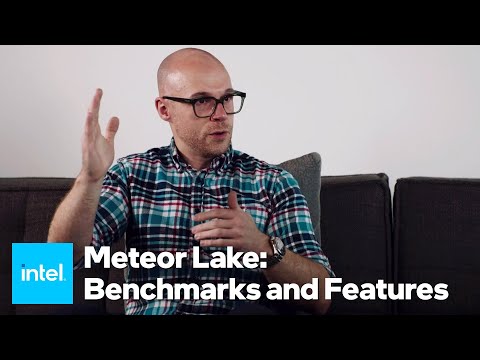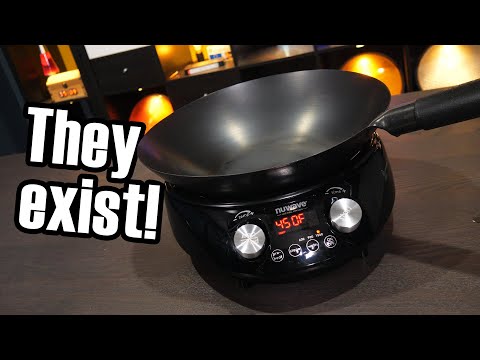Intel Core Ultra Features and Performance Overview | Talking Tech | Intel Technology

- Hi, welcome to Talking Tech. I'm your host Marcus Yam, and today we're here to unpack the news on Intel Core Ultra. That's code named Meteor Lake and this is the largest architectural change in client SoCs in 40 years. Joining me to talk more about that is Robert Hallock Senior Director of Client Performance Marketing.
Robert, thanks for joining Talking Tech. - Thanks for having me. This is fun.
- So what are YOU doing at Intel? (Robert chuckles) - What am I doing at Intel? Well, I've been officially hired to focus on AI performance for client CPUs but the role, the organization that I'm in handles performance in general for clients so notebook and desktop both. And so could be GPU performance, could be CPU, I tend to get involved on all of that. - Okay, so you said the word performance a number of times and that's clearly a good fit because Intel's priority is performance. But with Meteor Lake or Intel Core Ultra, I've heard the word efficiency used a whole lot more - That's true. - Than we're used to hearing.
So what's the story with efficiency and Intel Core Ultra? - Well, I think people who might be watching this have heard me many times over the past few years say that efficiency and performance are actually just two sides of the same coin. What we're seeing from the Core Ultra processor is just like an incredible improvement in performance per watt. And what that pays dividends on is like, you can sustain sort of the same traditional notebook power envelopes but deliver a lot more performance on the other side. And as I look at the code name Meteor Lake product that's true of graphics, that's true of the CPU cores, it's true of one individual CPU core. You can just extract more performance. But then when you need to do something lightweight, you can get down to much, much lower power.
Just as one example of that efficiency, we'll talk more about this, but I saw, like, a roughly 80% reduction in power consumption compared to Ryzen when you're just sitting at the desktop, which a lot of people do. So we're talking 80% less power sitting at the Windows desktop, and that's a huge, huge improvement on the Intel architecture. - What are some of the factors that contribute to such a big boost in efficiency? - There's a couple pieces, moving the Intel architecture tile to a new process node is a big part of that. Slightly improved processor cores with more IPC, more energy efficiency in the design, that's a big part of it. But then disaggregation, which I know people have heard a lot about, that plays a big role as well, because it allowed the correct process node the correct power characteristics on each tile to come out which makes the whole device more efficient on the other side. The active power, when the chip is kind of at rest plays a big role in overall battery life, overall power consumption, and so that's the SoC power, it's really, really good on Meteor Lake.
And so that creates this device that can scale to very low power when the system is idle and quiescent but deliver really good performance when you ramp it up to full blast. - And you're referring to a lot of the characteristics of this design that Intel's actually unpacked in the previous tech day. Those that have been following along on the Intel Technology Channel or the other news from Intel I know is that we can find out a lot more about the disaggregated design, Intel 4, Foveros. But, of course, the exciting news today is we can talk about performance. - Numbers, we can talk about numbers.
- Performance, efficiency, and how those fit together. So let's start with the compute tile performance. What do you have to share on that today? - Well, one of the things that I think is the big question is Raptor Lake and Alder Lake were sensational performance, industry leading performance, but I think Intel wasn't quite where it wanted to be on power, active power of the chip. So one of the things that I'm very pleased about in the Core Ultra family is that it delivers more multi-threading performance than Raptor Lake and roughly equivalent single thread performance but at much, much lower power better performance per watt. And that's kind of the key element of the CPU tile that's improved. So, that pays dividends everywhere.
It pays dividends when you're doing lightweight web browsing, it pays dividends when you're doing heaving sustained compute, it pays dividends when you're just reading a document. Power consumption is down in every category and that helps Intel get into a really good space on power. And then, you know, kind of keeping parity with Raptor Lake and 1T and pulling ahead on multi-thread.
So that's kind of a win-win, right? You've got competitive performance leadership, you've got generational performance increase, and you're doing it all at much lower power. - I mean, that's very exciting data there and of course we're gonna rely on the tech press and the professional benchmarkers- - To vet that, that's right. - To vet all that. But I also wanna come back and talk about the compute tile architecture because a lot of the innovation and the excitement that we had with 12th gen Alder Lake was the introduction of the performance hybrid architecture. - That's right. - So how has that changed or evolved in Intel Core Ultra? There's still the P-Cores and the E-Cores and now the E-Cores also have another place in the CPUs.
- Yeah, an even smaller set of E-Cores. So in the SoC tile, as press know, there are now two low-power island E-Cores. The big benefit of that is sort of predictable lightweight tasks like video playback or even background tasks can go to these even more low power cores. And just as an example of that, let's say you take a Raptor Lake product playing Netflix, people do Netflix, and compare top Raptor Lake part for a 28-watt notebook versus top core Ulta part for a 28-watt notebook, we're seeing 25% lower power because of those low power E-Cores.
And it's just because that workload can go resident on the low power E-Cores and the SoC tile and we get a much better efficiency result from that. So we shaved a quarter power off the top by having those cores. - I mean, those E-Cores or efficient cores are paying off again. - Absolutely. - Yeah. - Yeah, and it's actually difficult to measure the benefit because threads move around a lot, but video is one that stays very resident on those cores, I've read somewhere between like, 92, 95% residency on the cores for video playback. So that's a great to look at that, but those cores play dividends everywhere.
- And you've gotta give a lot of credit to the team behind the thread director and how it works with the software, especially with Windows 11. Going back to those P-Cores or Redwood Cove, - That's right. - And Crestmont, the E-Cores, what updates have we seen there? - Well, Crestmont, let's start with the E-Cores.
They picked up some VNNI instructions for inferencing, so some AI acceleration in the E-Cores. And then the P-Cores are slightly more performant at each frequency, but those are the big two. You get more performance, lower power, and on the E-Cores you get AI. - Okay, so that's compute. You've got the compute tile and low power island.
- That's right. - But there's another tile on Meteor Lake and that's the graphics tile. - Yeah, built-in graphics. - Built-in graphics. And I've also noticed that Intel Arc which is not more known or first known as Intel's discrete GPU.
- [Robert] That's right. - But now it's built into Meteor Lake. So tell me more about that. - I actually think this is a really cool story.
So Arc as a discrete graphics card debuts roughly two years ago, and fast-forward to now, got that same technology that Arc graphics built right into the CPU. So we're talking 28-watt CPUs here. And AMD has the Ryzen 7000 series, of course.
No disrespect to them, they have a great graphics core too but our is better. And that's a really good place to be. We're talking native 1080p medium in-game preset performance here. There's a wide range of frames per second, of course, because we're talking a bunch of different games, but we've looked at a broad spectrum of titles and we see across the board leadership and we're really proud of that. - Now, how should people be thinking about the relationship? 'Cause I know, I peeped the SKU table a little bit earlier so some of these Meteor Lake CPUs will have Arc whereas other ones will have Intel graphics. - That's right.
- What is the relationship between how someone should think about Intel Arc discrete graphics and the built-in Arc graphics? - Well, it's the same fundamental building blocks, same IP, right? So features that come into the graphics driver for discrete Arc, you'll be able to use those features like XeSS on the built-in graphics too or you can use endurance gaming or frame pacing to get longer battery life or more consistent frame times. These are all benefits that apply equally to standalone graphics or the built-in on Core Ultra. In terms of getting that graphics chip, there's really two forms of the Meteor Lake product.
There's Core Ultra the H and the Core Ultra U parts and it's the H parts with Arc graphics. So if you see Intel Core Ultra 7 I don't know, 165-H you see that H at the end, that's an Arc part, if it has dual channel memory in the system. And then U will be just the standard integrated built-in graphics.
- And I wanna talk touch another point a little bit more in a little bit more detail is that all the remarkable progress that the Intel software engineers have made on the- - [Richard] It's so good. - Yeah, on the Intel Arc discrete GPU drivers. Are those same benefits talking about performance, XeSS, are those also going to be available on Intel Arc? - That's right, that's the beauty of doing this integration and spending the time to get it right. You can essentially develop a shared driver, shared code base, shared feature base and so it really doesn't matter which Arc you have be it a PCI Express card or the built-in graphics core you get the same benefits, same features on both sides. - So this thin and light segment isn't typically one that, you know, big gamers really look at as a first thing for their dedicated gaming machine.
So can we talk a little bit about performance what people should expect should they wanna do some gaming on their Meteor Lake system? - I think I'm a perfect use case of this. I only have one notebook, it's my work notebook. And it is a 28-watt system. So I think the reality is a lot of people are in that situation and want to play some game sometime somewhere and the notebook that they have better be able to do that. And I'm not gonna say that Core Ultra is a gaming CPU, it's not. There are other choices for that.
But it can play a game and it can do it well. We're seeing very, very playable frame rates on a broad spectrum of games at 1080p, a medium in-game quality preset, you know, we're talking 40, 50, 70, 100 frames a second. I've seen games that are upwards of 150 frames a second and that's all in the notebook. And I think that's a really nice experience to have. There are lots of ultra-thin CPU choices in the market from other vendors, but not all of them can do that, not all of them can do the great CPU performance and the low power, and the graphics. It's rare to find that combination in the industry and Core Ultra delivers that.
- And of course, with XeSS, those resolutions you get a little bit of extra sampling bump on that. - That's a good point. The performance I'm talking about is just native 1080p, not even layering XeSS on top which is another, you know, (Robert chuckling) I've seen upwards of 40% performance improvement from XeSS on top, sometimes more. And so the quality's really good, it's easy to turn on, but we're just talking 1080p native, the graphics is really strong. - Okay, so you mentioned earlier that you were brought on to look over some of the AI performance side of things and it's pretty rare that I can hear anyone at Intel talk about Intel Core Ultra without hearing AI PC. - [Robert] Yeah, that's true.
- So what's an AI PC? How are these things fitting together? And I'm gonna ask you soon, like, how do you measure performance of AI on a device like this? - Well, I guess at a fundamental level an AI PC is simply a computer that has dedicated hardware to run AI workloads. It's not that old hardware couldn't do it, like, you can run an AI workload on a couple year old CPU but it takes forever. And this is one part performance and one part efficiency like we were talking about earlier.
Having these AI engines allows you to deliver a much faster runtime for the application but also drive to lower power both in watts and in total joules consumed for the time. How do you measure AI? Well, it's actually pretty conventional. A lot of the applications that are early AI are content creation so we're talking time to complete, maybe some of the synthetic benchmarks put out a composite score at the end but it looks very traditional in terms of benchmarking. We just now have different algorithms that we're running to do the benchmarking.
Performance is really solid. It's easier to just put that on-screen, so we'll do that. We'll show some numbers on the screen, but in general, one of the things I say we can take away is that Core Ultra is showing really robust compatibility.
Some of the competing vendors aren't able to run all the workloads that we've been looking at. Pretty key ones like Adobe Premiere or even the UL Procyon benchmark. We're the only one that has thoroughly running every single one of those tests. Our competitors have stumbled in some of those sub-tests or in some of those workloads. So, you know, one of the important points I wanna leave people with is it's not enough to have an AI accelerator, you also need to do the software work on the backend to make sure the stuff runs correctly on that accelerator. It's a lot like gaming, actually.
And Core Ultra has a really good showing in the compatibility department. The will it run or not question is a big one in AI 'cause it's so new, and Core Ultra looks really good. - So not just you're looking at performance can it do the work, but it's also how usable it is. Because think right now, we've had graphics benchmarks, we've had general compute benchmarks for so long and looking here now, it looks like compatibility as you've mentioned, is another big factor of can people actually make use of these AI features and actually use the accelerator. - Well, AI is actually a lot more like gaming than anything else.
You've got a vector math accelerator just like a GPU. Instead of graphics APIs you have models and runtimes. You have software work that needs to be done to enable those models or those APIs. It's very graphics-like.
And you even have teraflops for the GPU, TOPS for the NPU, and, you know, it's just interesting how this industry moves in repetitive cycles and it looks very graphics-like. So, if you think about gaming you have some GPUs that run certain game engines better than others. You launch a new game, maybe it doesn't run on some GPU 'cause they haven't done the driver update. That's compatibility stuff and AI is no different.
You've gotta put in the hard work to enable these runtimes, these models, these frameworks, these applications, and it takes a large software organization to get it done, and that's what Intel has, uniquely, by far the biggest. - Oh yeah, tens of thousands of software engineers at Intel, which is known as a silicon hardware company. - That's right, Intel in many ways is a software company not a hardware company, and that's critical for AI. And that's why you see these compatibility things coming to the surface because Intel has put in the hard work to make sure these things run correctly and other vendors maybe haven't gotten there yet. - So we've covered compute, we've covered GPU, and we've covered the NPU or AI.
How should people think about performance as a whole across these different compute tiles? - Well, what I see based on the data that I'm look at, I see a product that is head and shoulders above our previous generation in performance per watt. I see versus AMD, the other front-of-mind competitor for a lot of people who will be watching, I see stronger single thread performance, stronger multi-thread performance, stronger graphics performance, that's a one-two-three punch, that's great. In terms of CPU compute, it's faster than Qualcomm faster than Apple M3. At the end of the day, there are lots of choices and you gotta choose on power efficiency, CPU performance, graphics performance, and Core Ultra's very clearly leading in all three.
- So Intel Core Ultra, as usual, they are multiple flavors. We're gonna flash up the SKU tables so everyone can have that reference, but an you walk me through all the different flavors? There's the 45-watt, 28, and so on. Just help me understand which parts go where, what the capabilities of each are and how people should be thinking about that. - [Robert] Sure, so the H 28-watt H class, that'll be kind of the bulk of the market. For the high performance you get the built-in Arc graphics you get all the CPU performance we've been talking about today.
You get the AI performance we've been talking about. And then for sort of a traditional work environment, not a lot of gaming, not a lot of intense graphics, you've got the U Series. But it's at 15-watt, nice long battery life. And then you mentioned the 45, that's a 45-watt H. There's also a 9-watt U.
You'll see those in select systems. They won't be everywhere but we've got some interesting designs coming with those two parts in particular. - So plenty of options, you said lots of designs.
So how many are we looking at and when can people see them? - Through 2024, we'll have over 200 different designs across Intel Evo, vPro, standard systems, Intel NEX, working group. And then availability, December 14th. Announcement and availability on-shelf same day. That is not true of every CPU that's been announced recently but we're pretty proud of that. So yeah, right on-shelf on December 14th.
- So December 14th, jumping ahead of CES but I know a lot of these designs we're gonna actually be seeing, get our hands on them at CES. So I'm excited to see more about that, excited to get my hands of a production system. But that's really exciting. - Well, it's worth pointing out the laptop industry moves in cycles. CES is a big moment for laptops.
June-July for US Father's Day. Graduation season is a big cycle. Back to school's a big cycle.
So you can see the laptops throughout the year at those inflection points. - Never a bad time to upgrade but this is a really good time to upgrade. - This is a good one, yeah.
- Great. So of course, we've talked a lot about performance and features in this segment, of course, people should consult their favorite independent benchmark resource. And clearly we're very proud about the performance and its efficiency. - Yeah, it's a great part, it's a killer part. - So, Robert, this has been awesome. I wanna thank you from Talking Tech.
- Thanks. (soft music) (chiming music)
2023-12-19 11:17


